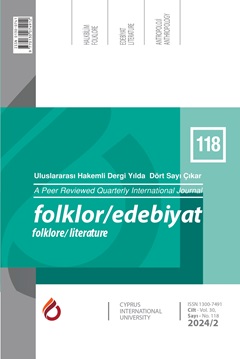Tahar Ben Jelloun’un Gitmek Adlı Yapıtına Oluşumsal Yapısalcı Bir Yaklaşım
A Genetic-Structuralistic Approach to Tahar Ben Jelloun’s Leaving Tangier
Author(s): Esma Sönmez ÖzSubject(s): Studies of Literature, Other Language Literature, Theory of Literature
Published by: Uluslararası Kıbrıs Üniversitesi
Keywords: immigration; culture; genetic structuralism; Tahar Ben Jelloun; Leaving Tangier;
Summary/Abstract: One of the eminent figures in contemporary French literature, Tahar Ben Jelloun, hails from Moroccan origins and remains deeply tethered to the land of his birth, upbringing, and residence, manifesting a profound engagement with Morocco in his literary endeavors. Noteworthy for his exploration of themes encompassing immigration, justice, identity, racism, culture, freedom, refugeeism, religion, and ethnicity, Ben Jelloun wields considerable influence within the literary sphere. His 2006 novel, “Leaving Tangier,” offers a poignant portrayal of Moroccan emigrants bound for Spain, featuring forty chapters, each dedicated to elucidating the experiences, sacrifices, and unfulfilled aspirations of distinct characters embarking on this journey. Within the narrative fabric of “Leaving Tangier,” Ben Jelloun confronts the harrowing realities of sexual and physical violence endured by migrants, thereby providing a nuanced depiction of Morocco’s multifaceted social, cultural, political, religious, and economic landscape through the lens of his characters. This study endeavors to subject “Leaving Tangier” to analysis through the lens of Lucien Goldmann’s sociological method known as Genetic Structuralism. Goldmann’s framework posits that the social, political, economic, religious, and cultural milieu exerts a direct influence on a writer’s creative process, thereby shaping the thematic and structural composition of literary works. Central to Goldmann’s approach are the concepts of “comprehension” and “explanation,” which seek to unveil the symbiotic relationship between the author, as the progenitor of the literary work, and the prevailing ethos of their society. The structural elements encompassing narrative perspective, spatial and temporal dimensions, and character dynamics within “Leaving Tangier” serve as conduits for the expression of both the author’s worldview and the broader societal and cultural milieu to which he belongs. Consequently, the novel is analysed within the framework of the method of Genetic Structuralism, which scrutinizes between structural form and sociological context. Accordingly, the restlessness of the society is reflected on the individuals, and due to social, political and economic reasons, individuals fall into difficult and uncanny migration routes.
Journal: Folklor/Edebiyat
- Issue Year: 30/2024
- Issue No: 118
- Page Range: 509-528
- Page Count: 20
- Language: Turkish

